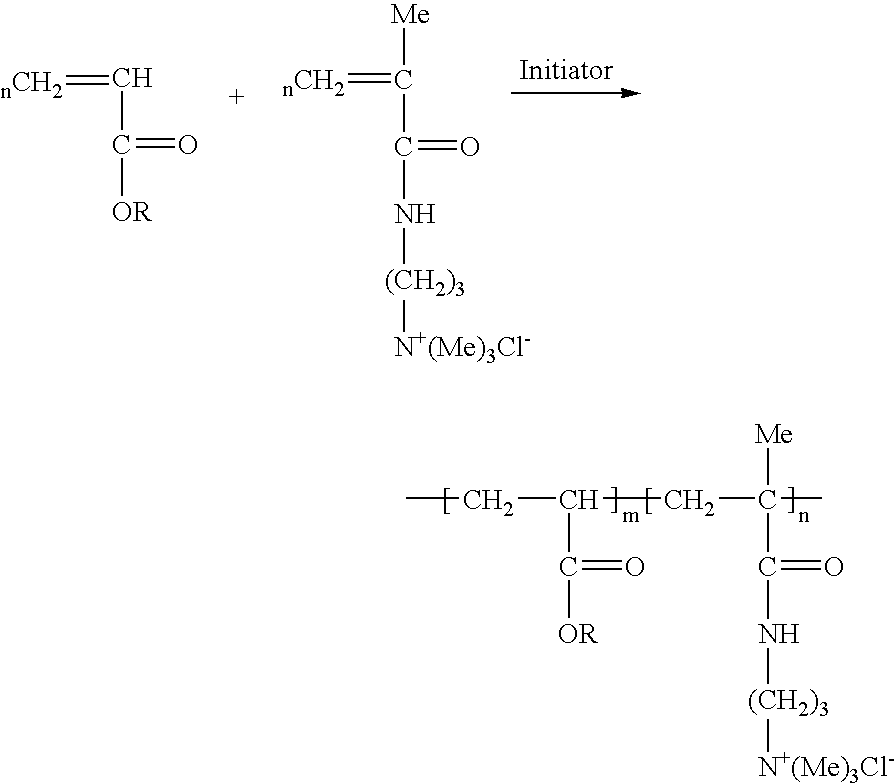Water soluble/dispersible and easy removable cationic adhesives and coating for paper recycling
a technology of cationic adhesives and paper recycling, applied in the direction of amide/imide polymer adhesives, adhesive types, etc., can solve the problems of reducing the quality of recycled paper, reducing the efficiency of machinery, and less efficient operation of conventional adhesives and coatings, and achieve good adhesion and cohesion properties, and high glass transition temperature or melting temperature
- Summary
- Abstract
- Description
- Claims
- Application Information
AI Technical Summary
Benefits of technology
Problems solved by technology
Method used
Image
Examples
examples
All of the following percentages are based by weight unless otherwise indicated.
examples 1 – 2
Examples 1–2
Emulsion P lymerization
[0038]Selected examples of polymeric adhesives prepared by emulsion polymerization are listed in Table 1. The solid content of the mixture was kept at 50%. The following method was used to form Example 2 and is exemplary of the steps used to prepare the adhesive samples. The following materials were added to a 250 ml reactor equipped with a mechanical stirrer and a nitrogen inlet tube: 41 g of deionized water, 38.5 g of butyl acrylate (BA), 14.6 g of a 50% solution of MAPTAC, 2.3 g of polyoxyethylene(40)isooctylcycldohexy ether, and 1.4 g of cetylammonium bromide (CTAB). The mixture was flushed with nitrogen for half an hour and heated to 60° C. After the temperature reached steady state, 0.23 g of 2,2′-azobis(N,N′-di methylene-isobutyramidine)di hydrochloride, which is an initiator, in 2 mL of water was added to the reaction mixture, and the reaction was continued for four more hours.
[0039]
TABLE 1SampleMonomer CompositionWeight RatioControl 1BA100...
examples 3 – 6
Examples 3–6
[0040]Table 2 lists selected samples of polymeric adhesives prepared by solution polymerization. The solid content of the mixture was kept at 40%. The following method was used to form Example 4 and is exemplary of the steps used to prepare the adhesive samples. The following materials were added to a 250 ml reactor equipped with a mechanical stirrer, a condenser and a nitrogen inlet: 92 g of ethanol, 25.6 g of butyl acrylate (BA) and 9.8 g of 50% MAPTAC. The mixture was flushed with nitrogen for half an hour and heated to 65° C. After the temperature reached steady state, 0.36 g of 2,2′-azobisisobutyronitrile (AIBN), which is an initiator, in 2 ml of acetone was added, and the reaction was continued for an additional four hours.
[0041]
TABLE 2SampleMonomer CompositionWeight ratioExample 3BA / MAPTAC91.7 / 8.3 Example 4BA / MAPTAC83.9 / 16.1Example 5BA / MAPTAC76.6 / 23.4Example 5aBA / MAPTAC / EGD76.4 / 23.3 / 0.3Example 5bBA / MAPTAC / EGD76.1 / 23.2 / 0.7Example 6BA / MAPTAC70...
PUM
| Property | Measurement | Unit |
|---|---|---|
| Time | aaaaa | aaaaa |
| Time | aaaaa | aaaaa |
| Time | aaaaa | aaaaa |
Abstract
Description
Claims
Application Information
 Login to View More
Login to View More - R&D
- Intellectual Property
- Life Sciences
- Materials
- Tech Scout
- Unparalleled Data Quality
- Higher Quality Content
- 60% Fewer Hallucinations
Browse by: Latest US Patents, China's latest patents, Technical Efficacy Thesaurus, Application Domain, Technology Topic, Popular Technical Reports.
© 2025 PatSnap. All rights reserved.Legal|Privacy policy|Modern Slavery Act Transparency Statement|Sitemap|About US| Contact US: help@patsnap.com


